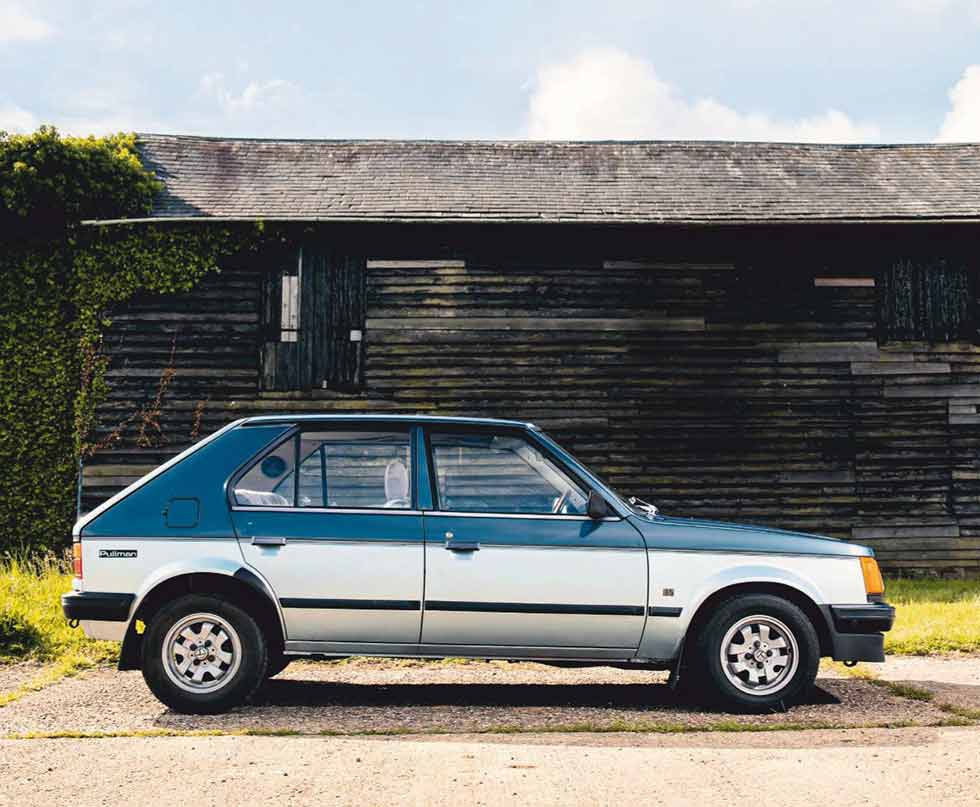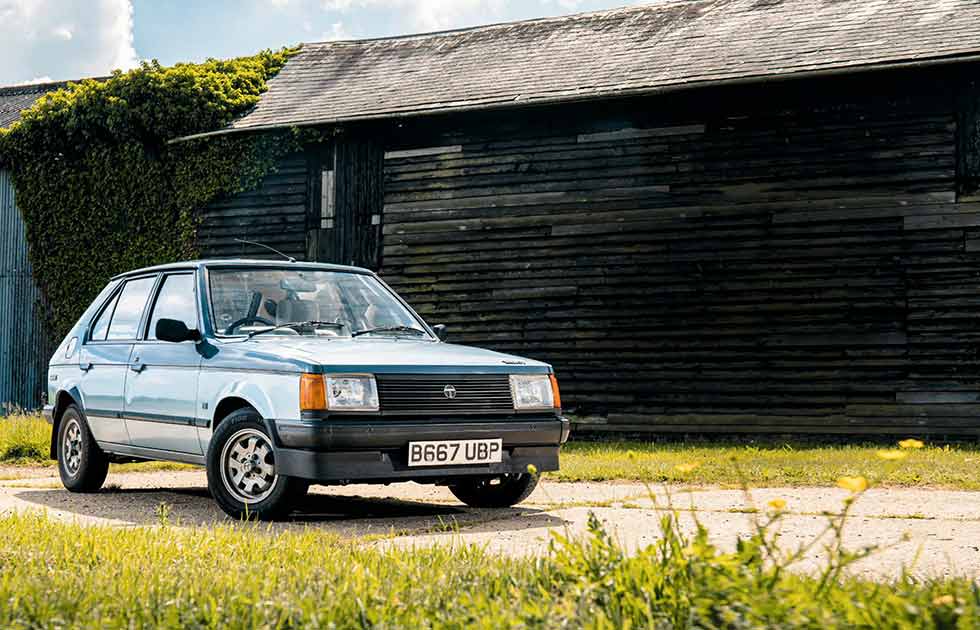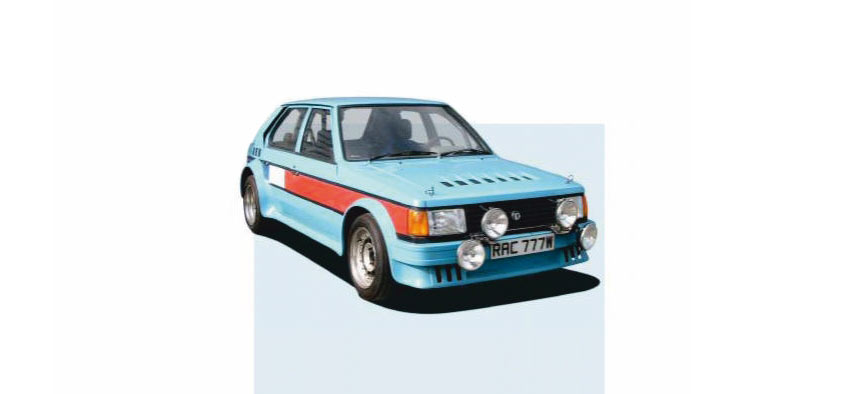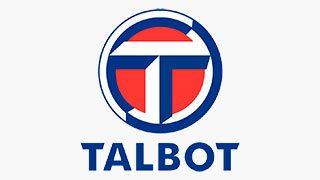
Enjoying Talbot Horizon The first ‘world car’ that the we all forgot Overlooked and now almost forgotten, Talbot’s Horizon was one of the most groundbreaking cars of modern times. Words Sam Dawson. Photography Jonathan Fleetwood.
NEW HORIZONS
The Talbot Horizon was a revolutionary car, but this hasn’t stopped numbers dwindling. We find out why those left need to be saved.
ENDANGERED SPECIES: TALBOT HORIZON
A game-changing car that everyone has forgotten We remind you why this car deserves to survive
Only 14 Left
WHAT TO PAY
Concours £5000
Good £3000
Usable £1000
Project £500
What, would you say, was the first modern family car? Forget about various pioneers of mechanical minutiae for a second and think instead about the global picture. Big automotive conglomerates owning multiple brands seeking to dominate every world market. A single platform and set of mechanical bits that can be reworked and presented under a plethora of completely convincing guises, be they sporty, luxurious, practical or rugged according to assorted packages of easily-attached options, yet still fundamentally remaining the same car. And for modernity’s sake, let’s say it has to be a five-door, front-wheel-drive, transverse-engined hatchback.

You’re thinking Golf, aren’t you? A single model underpinning most of the Volkswagen, Skoda, Seat and Audi ranges. But in the Golf’s case that wouldn’t come about until the PQ34 platform of the late 1990s. The Talbot Horizon, on the other hand, performed this trick 20 years earlier. And what’s more impressive is that it did it pretty much by accident.
‘RIDE WIZARDRY BY TORSION BAR. FORGET THE TALBOT BADGE – THIS IS PURE 1980S PEUGEOT’
In the 1970s, Chrysler was that big global conglomerate. In the wake of the 1973 oil crisis, the new MkI Volkswagen Golf was eating into the sales of American compact cars, many of which were comically bad – think Ford Pinto, which exploded when rear-ended thanks to an unfortunately-located fuel tank, or AMC Gremlin, a small three-door hatchback in which the standard ‘economy’ engine was a 3.3-litre straight-six. Chrysler needed a modern and compact hatchback, not just for its domestic Dodge and Plymouth brands to fend off the German invasion, but also for its Chrysler Europe subsidiary to replace the ancient Simca 1100 and take on the all-conquering Golf.

In truly modern style, the Chrysler project was a collaborative effort involving its multiple subsidiaries. Roy Axe – designer of the ‘scaled-down-Interceptor’ Sunbeam Rapier – devised and styled it at the old Rootes Group design centre at Whitley, Coventry. Then it was handed over to Simca to be engineered and developed in France. Once finished, the tooling for this crisp five-door was set up in factories at Poissy in France, where it was a Simca, and Madrid in Spain where it was built for other mainland European markets as a Chrysler. In Ryton-on-Dunsmore, it was a Talbot, replacing the Hillman Avenger. And in Belvidere, Illinois, initially with 1.7-litre engines bought in from its arch-rival Volkswagen, it became the cheap, basic Plymouth and the butch, sporty Dodge Omni.
‘CHRYSLER EUROPE WAS SOLD TO PEUGEOT’S PARENT COMPANY FOR JUST $1’
The reception was ecstatic. This true ‘world car’ won European Car of the Year and Motor Trend Car of the Year with ease. And then, within months of its worldwide launch, Chrysler Europe collapsed, nearly taking the Horizon with it.
The Horizon was actually part of the problem. The downsized likes of the Ford Pinto, Chevrolet Vega and AMC Gremlin may have been hopeless compared to properly-engineered small imports like the Golf, but they sold well in the US. The Horizon, no matter how revolutionary its design, seemed part of a too-little, too-late response from Chrysler to a changing motoring landscape.
The company was near-bankrupt by 1979. Lee Iacocca – the ex-Ford genius who created the Mustang – joined as CEO and set to work on cutting Chrysler’s losses. Chrysler Europe – comprising the old Rootes group in the UK, Simca in France and Barreiros in Spain – was sold to Peugeot’s parent-company PSA for just $1. But Iacocca was one of the shrewdest men the car world had ever seen. He ensured the intellectual property terms of the Peugeot deal meant both PSA and Chrysler could build and develop the Horizon in their own individual ways.
I was born in 1983, so to me the Horizon has pretty much always been a used car. They seemed to deteriorate rapidly compared to Ford, Vauxhall and Austin stock, with Simca-derived engines that would rattle when servicing was skipped, and flat panelwork that would be consumed from the ground up by rust.
They dated rapidly too. The simple sharp-edged-box shape Axe designed in a hurry, clearly with an eye on a MkI Golf, looked ancient the second that aero-smoothed rivals like the MkII Vauxhall Astra appeared. I’m looking at this 1984 Pullman special-edition with fresh eyes though. It’s still nondescript and boxy, but among bloated, overdetailed hatchbacks desperate to build a flashy brand identity it looks pleasantly understated. ‘Neat’ sums it up. It may have been largely French in conception, but there’s no Citroën avantgardery, Renault sportiness or Peugeot design-house style on show here.
What the Horizon has on its side instead is cleverness. It’s in the way the parcel shelf hinges downwards into the rear bench when you fold the back seats, creating a completely flat boot floor that would shame an estate. Open the bonnet and be impressed by the well thought-out and accessible layout, with items like the power-steering assembly and a spark controlling ECU – one of the first seen outside of the luxury market – bolted in plain sight on top of the wheelarches on well-designed curved plinths, rather than buried away in a fiddly box under the scuttle or deep in the engine bay bowels. The sense of modernity continues as I deactivate the central locking, open the surprisingly substantial-feeling driver’s door and step inside. Get into even a MkI Golf and, if you’re used to modern hatches, you’ll be alarmed by its lack of shoulder room.
Not so here. By modern standards the Horizon is supermini-sized, but it feels wide, airy and comfortable inside. Unable to afford to develop a completely new platform for the Horizon, Talbot shortened the underpinnings of the big Alpine saloon, resulting in nippy hatchback length and comfortable repmobile girth.
With its soft, deeply-padded velour and fake wood-veneer dashboard, this Pullman was the range-topper, replacing the old Hillman Hunter-based Humber Sceptre baby-luxury-saloon. Owner Colin Hill suspects it was a demonstrator built for the NEC motor show given that it boasts every single available option, including the power steering and automatic gearbox more usually found on the Dodge and Plymouth versions. No choke-pulling is needed to fire it up – instead, a strange pressurized water-bottle reservoir, controlled by a heat activated bi-metallic strip adjusts it for you on the turn of the ignition key, gunning the engine as straightforwardly as a modern injected car. The dashboard is dominated by a big analogue speedometer, flanked on the right by a digital tacho. It may generate a blur of blue-green numbers most of the time, but it did bring digital tech to the hatchback sector before Audi’s fully-digital dash on the later quattros. Pull away, and it immediately impresses with its smoothness. Those torsion bars give it a Citroën-shaming ride and this 1442cc Simca engine is well maintained, emitting only a well-suppressed hum. There’s no slurring or over-revving on the three speed automatic ‘box either.
Then I pitch it into a complex of rural Essex bands, and it really surprises. The power-assisted steering is, again, modern-feeling, fingertip-light yet with enough feel. It may feel soft – these incredibly comfy seats and the 175/70 R13 tyres help – but well-calibrated torsion bars combine the decadent smoothness of a luxury saloon with the cornering agility of a Golf GTI. It’s the PSA ownership. Ride and handling wizardry by torsion bar. Forget the Talbot badge – this is pure 1980s Peugeot feel, years before any of the fêted ’05’ cars emerged from Sochaux. This car laid the groundwork for the success of the Golf GTI’s greatest nemesis, the 205 GTI.
And yet, with the exception of one turbo 1294cc prototype, Europe never got a Golf GTI-chasing Horizon. So far as Peugeot was concerned, the Horizon had done its job and in 1986, just as Peugeot was enjoying an successful rebirth in the showroom and on the rally stage, the Horizon was discontinued. But things were different in the US. With Simca out of the picture, US-friendly 2.2-litre Chrysler Trenton four-cylinders formed the backbone of the Dodge Omni range. These were shared with the Dodge Charger – a front-driven shadow of its former self. Carroll Shelby was recruited to pump the volume up, adding Bosch fuel injection and a Garrett T3 turbo. The Charger’s image was rehabilitated and the engine technology went straight into the Omni.
Chrysler wanted to call it the Coyote, but Shelby overruled them. They became the GLH (‘Goes Like Hell’) and the 1000kg, 175bhp, 135mph GLH-S (‘Some More’). Like Nigel Mansell morally defending his F1 Championship victory by taking the fight to the US in IndyCar, this European world-car managed to get one over VW as a sports car as well as a hatchback.
The name almost came back in 2008. The name almost came back in 2008. Optimistic speedos an ’80s norm. Colin’s Horizon came fully loaded. When fake wood and a clock was fancy. It even came with its own conductor. This is the tachometer. No, really. Autochoke ‘sensor’. Hubcab logo by MC Escher. Sharp lines the equal of the 205’s? This wheel and the myriad options make Colin’s Horizon a likely candidate for the NEC Motor Show car. They did a mad 175bhp turbo in the US. Two-tone paint schemes never quite took off.
Modern Classics View
For a car with such a significant legacy – the first modern multi-brand hatchback as we know it, and the most influential factor in the evolution of Peugeot – the Talbot Horizon has been criminally overlooked.
Admittedly, its nondescript styling doesn’t help, nor does the fact that it lives in two very long shadows – those cast by both Talbot’s lairy rallying superstar of the time, the Sunbeam-Lotus, and the Pininfarina-styled Peugeots which came after it to steal away the limelight.
And yet it’s a missing link in the modern automotive landscape, a landmark car that deserves preservation, if only to stop VW fanboys from rewriting history. Its European engineering helped drag American motoring out of prehistory, and it simultaneously brought American product-planning and marketing knowhow to Europe. The fact that the retro-cool scene has latched onto the MkI Golf, even in non-GTI guise, as a memory worth preserving serves to push it yet further from public consciousness.
Talbot Horizon Pullman
Engine 1442cc, 4-cyl, OHV
Transmission FWD, 3-speed automatic
Max Power 82bhp @ 5200rpm
Max Torque 91lb-ft @ 3000rpm
Weight 970kg
PERFORMANCE
0-60mph 12.3sec
Top speed 97mph
Economy 43mpg
BOUGHT ONE COLIN HILL
‘They need good maintenance, otherwise they get clattery,’ says Colin Hill, go-to source of parts for classic Chrysler Europe cars. ‘Most mechanical parts are available cheaply, especially from France, but the tricky bits are interior trim and plastic clips.
Nobody’s made any of those parts for a long time, especially for the Pullman – only 500 were made. Body panels rotted, but the structure was better protected than other cars.’
GROUP B RALLY PROTOTYPE
How a failed Horizon project led to the T16
The Horizon was born into an odd period for world rallying. Talbot didn’t feel the need to endow it with a sporty image, because that was the Talbot Sunbeam’s job. That cheap attempt at rivalling the VW Golf used a shortened Hillman Avenger platform which gave it rear wheel drive, and in a rallying world dominated by Ford Escorts, all that was needed was a Lotus Type 911 engine to make it a world-beater, winning the World Rally Championship in 1981.
But there was a new threat in the form of the Renault 5 Turbo. This flyweight mid-engined turbocharged hatchback won the 1981 season-opening Monte Carlo Rally fresh out of the box and Heralded what was to become the Group B revolution. After that shock win Citroën’s Head of Competition, Guy Verrier, tasked all rally-engineering outfits Associated with the brand to come up with PSA’s answer to the 5 Turbo. Des O’Dell, who headed up the Competitions Department at Talbot, had the exact-same idea, and picked the new Horizon as his basis for a rally car.

Beneath the silhouette bodywork was the chassis of a Lotus Europa – out of production six years by this point. Amidships, it ran a turbocharged two-litre Lotus 907 driving the rear wheels via a ZF transaxle. With 300bhp and 220lb-ft of torque, it was tested by Stig Blomqvist, recording 0-60mph in five seconds and 0-100 in 11.6 – easily capable of beating the Renault, even though its construction wasn’t conducive to mass-production in the way the 5 Turbo’s was.
By the end of the 1981 Championship season, even as Des O’Dell raised the Manufacturer’s title silverware, it had become clear that PSA had another problem, the four-wheel drive Audi quattro. The rear-drive Horizon had been rendered obsolete in less than a year. Drawing the strength of its various rallying departments together as Peugeot Talbot Sport under the directorship of Jean Todt, the Lotus Horizon was shelved. However, the idea of combining a mid-engined hatchback with four-wheel drive resulted in the devastatingly effective Peugeot 205 T16.






